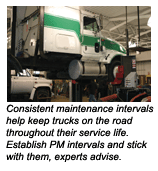It’s been said that a correctly specified and properly maintained truck can last forever. While that might be a bit of a stretch, when you talk about “forever” referring to a truck’s life, you need to understand that the word really means longer than someone is willing to drive it or you’re willing to pay for the increasing cost of keeping it alive.

“Forever” is a relative term for fleet managers. Economics, driver retention and shop capabilities will affect how long a truck is expected to live in a fleet. And it’s the expected end of life that normally will determine just how much time and money is spent on repairs that are found needed by a routine preventive maintenance inspection for high mileage or advanced age vehicles.
“Maintaining a truck from a safety and reliability point of view is one thing,” says Vince DiShino, business development manager at Regional International Idealease in Rochester, N.Y. “Maintaining it so it always looks like new is another issue.”
Fleet operations differ so the goals of maintenance programs will differ. Leasing companies, for example, need to decide before a vehicle is spec’ed just how long that truck is going to be in service and what’s going to be done with it at the end of its first service life. Those decisions, along with the OEM’s service recommendations, will determine how that vehicle is to be maintained.
Operators who are using their trucks every day to haul products are, of course, quite different from that leasing company – and highly varied among themselves. Some fleet managers might want to trade their trucks every three years. Others are looking for a million miles before they retire them. The fact that a fleet in the second group will realize very little for those high-mileage vehicles becomes a determining factor in the decision of how much will go into them in the latter years.
“There’s a point of diminishing returns,” says Darry Stuart, president of Quickway Transportation. “You probably wouldn’t put two new doors on a 15-year old truck. You’ll let them rattle a bit more than you would if it were a newer truck.”
Establishing PM schedules
None of this defines how or if PM schedules should change as a vehicle ages.
“PM schedules should remain constant, just as outlined in the owner’s maintenance and lubrication guide,” says Jerry Warmkessel, a sales engineer at Mack Trucks.

And that certainly makes sense. To keep a truck safe and on the road, the same items need to be checked whether a truck is three years old or 10 years old.
“The real question is whether the truck can make it to the next PM inspection,” Stuart says.
That requires an extensive and well-planned PM, and Stuart supplies one to shop technicians as illustrated in the PM instructions for a technician’s PM inspection of a rear suspension (Figure 1) – just one of 92 items on the PM check list he has developed.
DiShino echoes the concept saying, “Whether it’s new or old, you need to check the same things on a truck.”
For an older vehicle, however, expect more follow up repair work as a result of a thorough PM inspections. As a result, the time allocated for a PMI and its resulting repairs will likely need to be modified as a vehicle ages.
For many years, Columbia, S.C.-based, Southeastern Freight Lines was a fleet that had been looking for a million miles from its line haul trucks and 12 years or 450,000 miles from its city trucks. That’s now changing and will likely drop to 850,000 miles for over-the-road trucks and 10 years or 300,000 miles for P&D units.
“At one point, we were seeing equipment lasting a lot longer than it had earlier,” says David Foster, vice president of field maintenance. “In our opinion, it’s going the other way now.”
Southeastern establishes PM schedules for new trucks when they come into service and keeps those schedules throughout the trucks’ service lives. It generally has no routine plan to change PM schedules as vehicles age but will modify schedules since it regularly changes specs for new purchases and different components are always coming into the fleet. It’s the needs of the equipment that drives its PM schedules. Foster says of a schedule developed for a new vehicle purchase, “The new schedule will likely be used until the vehicle is retired.”
While Southeastern is a fleet that has found success through the long-term use of PM schedules based on those recommended by truck and component OEMs, it also is open to change based on new information. And review of regular oil analysis is something that can provide the kind of information needed to cause a change. As a result of consistent oil analysis reports of engines used in city service, the fleet has moved from a three-month oil change interval to a six-month interval.
“We still bring those trucks into the shop every three months to do an “A” service – greasing and looking it over,” Foster says. “You have to touch and look at the equipment on a regular basis.”
OEMs have their say
While truck OEMs offer standard and extended warranties, they have avoided any reputation of walking away from longer term responsibilities. While fleet managers would like to see longer lived components, trucks and their components have improved over the years. It’s not surprising, therefore, that OEMs take the position that premature component failure is generally due to misapplication, abuse or poor maintenance.
“Typically premature wear of many components on Class 8 trucks is a result of driver abuse or maintenance neglect rather than application induced,” says Warmkessel. “Applications require a properly spec’ed vehicle as well as vehicle use in line with the intended application. If a vehicle is spec’ed, driven and maintained properly, premature wear of all components should not be an issue.”
IT is not expected nor necessarily desirable for trucks to last forever. Everything will wear out and need replacement and trucks are no exception.
“Everything has a finite life, a life that is affected by application and proper maintenance,” says Charlie Allen, national service director for ArvinMeritor. “In fact, proper application is the key to obtaining maximum component life.”
Vehicle manufacturers work closely with component suppliers to deliver a vehicle that incorporates components that all have similar maintenance intervals. International Truck and Engine, for example, has a serviceability team at its engineering headquarters in Fort Wayne, Ind., which works with suppliers to develop components with what the company calls “synchronized maintenance intervals.”
“As a result, a supplier might change the amount of lubricant or type of lubricant to produce a component with the desired maintenance interval,” says Brian Mulshine, the company’s manager of service development and marketing.
Most fleet managers would love it if their equipment experienced some extended wear but would be more than happy with “normal” wear of vehicle components. Everyone knows that tires will wear, yet wants to make sure they wear no faster than “normal.” Good maintenance, the right specs and lack of abuse will help. The same holds true for brakes, clutches and suspension components. While premature wear can and should be avoided, some component wear must be expected.
“Normal wear cannot be delayed by any means other than not using the vehicle,” says Warmkessel.
Predictive maintenance
No one wants a road breakdown, so the idea of changing a component that could cause one, just before it does, has to be an idea that would appeal to everyone. That’s called predictive maintenance.
The problem, of course, is knowing when “just before it does” takes place. Some fleets make use of the concept and are happy with the results. Some are skeptical. Others simply reject it. Most positions seem to be based on personal experiences.
“Predictive maintenance sounds good, but can only work if you have a reasonable number of similar vehicles being used in a similar application,” says DiShino. “Without that you cannot generate good average data.”
He tells the story of supervising a seven-truck fleet on a five-year lease. Each ran 80,000 miles annually. At the end of the lease, there was less than 5,000 miles between the truck with the most miles and the one with the least. Maintenance costs varied less that 1.2 cents per mile over the five years for the trucks. Despite all this he found there was absolutely no similarity for the reason of those costs – a radiator for one, an alternator for another.
“How could any valid prediction have been made, he said.”
Also based on personal experience, Stuart says, “I don’t believe in predictive maintenance. The longest prediction you need to make is from one PM to the next.”
Warmkessel, on the other hand, is a believer in predictive maintenance. When asked if it’s economically possible, he says, “Absolutely. Due to many variables, the customer’s service records are the best way to predictive maintenance. Component life may vary due to vehicle application, geographic location, climate and driver habits. Typically, fleets can establish a pattern of component failure for their trucks based on these variables. Performing predictive maintenance is critical for a fleet that services just-in-time deliveries.”
International’s Mulshine says some developments result not in predictive maintenance but in real-time maintenance. Suppliers are working on, or actually offering, sensors that define the need for a component replacement or a maintenance procedure. Consider, for example, a sensor in an oil sump that determines the condition of the engine oil and tells you when in needs to be changed. Tire suppliers already are delivering tires that contain sensors that report on the condition of the tire.
Management, key to quality
There’s good news and bad news when it comes to PMs of high-mileage vehicles. The good news is that you don’t really have to do anything new. Just continue with thorough inspections on the same schedule. The bad news is that you need to have a program of thorough inspections performed regularly that began when the truck first entered service. Too often equipment managers limit the time a technician is able to spend on a PM. That’s a mistake, according to Stuart.
“You have to have a very thorough PM inspection,” he says.
But what you do with the results of that inspection will be reflected in the quality of future inspections. There’s no escaping the fact that trucks will demand more and more work to keep them in a safe, reliable condition as they age. The need for this work will often be found during a PM inspection.
What you do with that finding will determine the quality of future PM inspections. If you refuse the needed repairs because the truck is “too old,” what are the chances of your technician simply skipping that item the next time the truck comes in for service? As DiShino says, “The attitude of management will be reflected in PMI quality.” That, of course, holds true whether a truck is brand new or is about to deliver its expected million miles.


